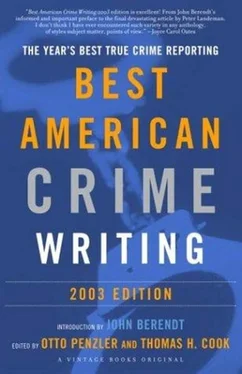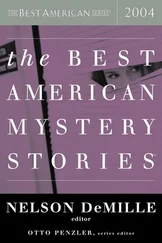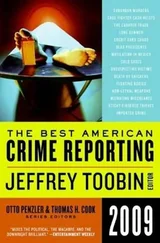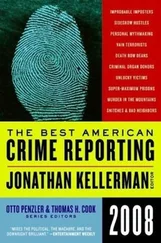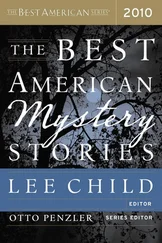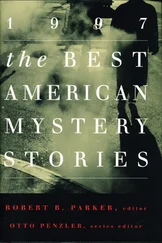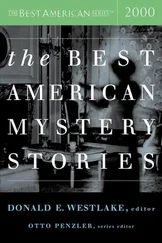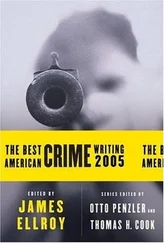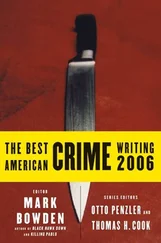Marcelo, the translator, lives just across the road and says that every year a few inmates are killed by other prisoners or guards, and another half-dozen escape. “It’s okay, I guess,” Marcelo says. “They usually run into the woods and not toward my house.”
A Franciscan friar who runs a mission at the prison agrees to take us to meet the six suspects. We arrive just after lunch. When you’re done with your meal at the Amapá State Prison, you simply throw what remains out through the bars of your cell, so the hall is covered with rice and what appear to be bits of chicken. Beneath that odor is the funk of food rotted into concrete and the stink of fifty men in equatorial heat. Some of the inmates make noises as we walk past-quasi-menacing laughter, unintelligible grumbling, a convincing pig squeal.
All six of the accused are housed in the same cell, which looks to be about six feet across and twelve feet deep. When they hear our approach, they get up from their hammocks, which are slung across the middle of the room, and make some effort to clean up a bit. Ricardo, the shooter, puts on a shirt, and Rubens pushes some clothes into a corner. They all come to the cell door and look at me curiously. The friar says, “You’re the first white reporter they’ve met.” The guard tells us we have an hour to talk, then leads us to a concrete bench outside the cell block and waits at the gate.
In the pictures published all over the world two days after the murder, the pirates looked like a bunch of guys pulled in from a barbecue, wearing soccer shorts and sandals. In person, they look even less intimidating. Only Isael looks like someone you’d be scared of, with a big scar across his belly and a muscular body with a very low center of gravity. The gunshot wounds to the hand and forearm don’t hurt, either. Reney, on the other hand, has delicate features and soft, velvety black eyes. He doesn’t look so different from Ralph Macchio, circa The Karate Kid .
“We are being treated worse than anyone else here,” Ricardo says. “We have been tortured. Show them, José.” José stands up and pulls down his shorts. His ass is covered in big black-and-yellow bruises, which, he says, were administered with an iron bar wrapped in a towel. Isael puts his arm forward and says he hasn’t been allowed to see a doctor in a week. The wound on his forearm, about eight inches long and closed crudely with some black thread, looks unnaturally wet. He unwraps the bandage on his hand and shows where the two fingers closest to his pinkie were shot off at the knuckle.
José, who’s called Grande Blanco (roughly, “Big Whitey”) and has remarkable jug ears and a prominent jaw, says, “It’s not like the media is saying that we are used to doing this job. This is the first time we killed someone-” and then Ricardo cuts him off. The police say Ricardo was the mastermind, and he seems to control the group. He rarely allows any of the others to speak.
One thing I wanted to ask when I came to see them in prison was, given that they didn’t set out to murder a man, how they felt when they realized they had. This was, after all, possibly the crucial moment in their lives. The group looks to Ricardo for an answer: “We did not know what happened. We never went down below deck to see him. We knew only that his shooting had stopped and so we left the boat.” I don’t point out that this can’t be true, since they stole Blake’s rifle.
I ask them if there is anything they want to ask me. Ricardo says, “What is the main religion in Peter Blake’s country?” I say I think they are mainly Protestant, and ask why he wants to know. “I’m Catholic,” he says, “so I would like to know. It’s important.”
Jose says, “I have a question. What did you think of us before? And how do you think of us now? We aren’t what they say we are, right? We are not pirates, river rats.” I tell him I hadn’t known much about them other than that they’d killed Peter Blake while trying to rob him. “Well, I don’t think it’s right, what they’re saying about us. You know, I’ve never been convicted of any crimes before.” The criminals now find themselves infamous, cast in a role larger than they had before. Ricardo seems to see the appeal of it. Jose, though, is scared shitless that he’s lost his former identity as simple local screwup, a feeling that thirty years in prison will probably relieve him of. Jose says, “I swear, I never could imagine that the story would end this way.”
If things had gone according to script, it would have been the Southern Ocean that killed Peter Blake. The Southern Ocean is roughly eight million square miles spreading out from Antarctica. It was the most dangerous and crucial leg of his five Whitbreads and two Jules Vernes, and Blake liked to call it the loneliest place on earth. He said often, “If you get into trouble down there, well, no use crying to Mum.” And trouble was inevitably what you’d find in the Southern Ocean. It was a wind-and-weather factory of unrivaled proportions, and Blake called the swells there “liquid Himalayas.” “The real danger,” he said, “is the bow digging in and the boat flipping end over end.” He built little hatches on the hull of ENZA New Zealand so he could climb out if this happened, not that there’d be much he could have done, sitting on an upside-down boat in the middle of the loneliest place on earth. Blake’s friends and colleagues paint the relationship between him and the Southern Ocean like the relationship between, say, Rocky and Apollo Creed-the chummy, mortal respect reserved for worthy adversaries. It’s not that Peter Blake did not realize that he was, like everyone else, a pawn of fate; it’s just that when fate showed up on his boat, dressed in a motorcycle helmet and a grimy T-shirt, he failed to recognize it.
***
I went to Brazil just before Christmas last year to report a story on the death of Peter Blake for Men’s Journal, where I was working at the time. Yd like to say I was drawn to the story because of some overarching theme it brought up for me. But the truth is that a story appeared in The New York Times one morning about a world-famous sailor who’d been killed by pirates on the Amazon. It was a kind of no-brainer Men’s Journal story, plus I had not written a piece in a while and I was afraid I was going to be fired. I am usually afraid I’m going to be fired. So I flew to Macapá, Brazil, a town I had never heard of before, found a translator who spoke maybe fifth-grade English, and drove around Equatorial Brazil in a rented Fiat, almost always in danger of being robbed by drunk people with machetes .
There was, nonetheless, plenty of adventure and discovery in the reporting of this story. The thrill of finding yourself in a town you’ve never heard of before, suddenly integrated into its community of policemen and lawyers and criminals, cannot be overstated. The editor of Men’s Journal largely wanted me to write about the life of Peter Blake. He was, after all, a Men’s Journal kind of guy-intrepid adventurer, naturalist, celebrity. But to me, his life was just another example of bored rich people creating challenges for themselves where none naturally exist (if Blake wanted to circumnavigate the globe, British Airways would have done it more quickly and cheaply, and with more free pretzels). I was more interested in the families of the killers, in the neighborhoods where they lived, in the concrete stadium built over the equator for dancing competitions, and in the masses of children flying kites at dusk. It’s always reassuring to go to some distant outpost and discover just how enormous and varied and confusing the world is .
One night, in my hotel room, I became convinced that bandits with pistols were going to climb through my window, steal my stash of American currency and Clif Bars, and leave me bleeding on the floor. And suddenly just how obscene Peter Blake’s death was seemed very real. Blake had simply been a curious man passing through a town that meant almost nothing to him, not so different from me. It was a humanizing moment. That it took my feeling threatened is, I know, kind of pathetic, but I blame fame; it can take away a person’s person-ness and make him seem more like a brand. The more I drove around Macapá in my rented Fiat learning about the night Blake was murdered, about the people involved, the more I became fascinated with the confluence of lives, with the perfect-storm-like escalation of events, the loss of control, the spontaneous combustion that resulted in a tragedy that no one involved had wanted .
Читать дальше
